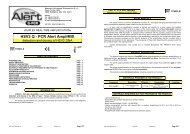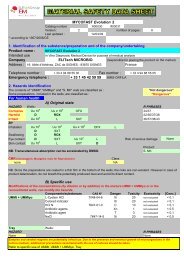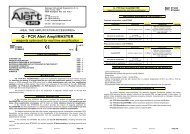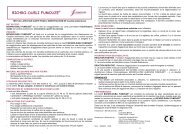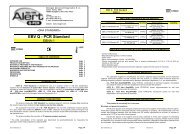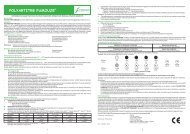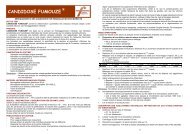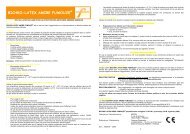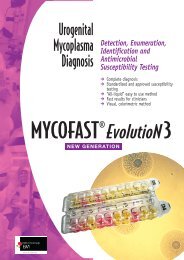GLABRATA R.T.T. FUMOUZE
GLABRATA R.T.T. FUMOUZE
GLABRATA R.T.T. FUMOUZE
Create successful ePaper yourself
Turn your PDF publications into a flip-book with our unique Google optimized e-Paper software.
<strong>GLABRATA</strong> R.T.T. FUMOUZE ®(« Rapid Trehalose Test »)Test d’identification de Candida glabrataINTERET DU TEST :Les levures du genre Candida peuvent être à l'origine de candidoses cutanées, muqueuses ou systémiques.Les Candida sont des levures habituellement commensales des muqueuses digestives et urogénitales. Elles nedeviennent pathogènes que lorsque des conditions favorables se présentent dans l’organisme hôte. Parmi les facteursfavorisant l’infection candidosique, on distingue des facteurs intrinsèques physiologiques ou pathologiques (âgesextrêmes de la vie, grossesse, diabète, déficits immunitaires et maladies malignes) et des facteurs extrinsèques qui sontessentiellement de nature iatrogène (11). La prévalence des candidoses a considérablement augmenté au cours des 20dernières années, par suite de l'émergence de nouvelles pathologies comme le SIDA, de la généralisation destraitements antibiotiques et des contraceptifs oraux, du développement des thérapeutiques immunosuppressives, del’alimentation parentérale, de la multiplication des méthodes d’investigations agressives et des interventions chirurgicales.A titre d'exemple les candidémies représentent environ 10 % de l'ensemble des infections nosocomiales, ce pourcentagepouvant même atteindre 20 % selon certaines études. En outre, leur pronostic reste très sombre, la mortalité oscillantchez les patients fongémiques entre 38 et 50 %.C. albicans est l'espèce la plus souvent isolée. Elle représente 60 à 80 % des isolats cliniques. Toutefois, d'autresespèces telles que C. dubliniensis, une espèce très proche de C. albicans, C. glabrata, C. tropicalis, C. krusei, C.lusitaniae, C. parapsilosis, C. lipolytica, sont de plus en plus fréquemment signalées comme agents de mycoses.C. glabrata représente selon les études 5 à 25 % des isolements de levures en mycologie médicale. En terme defréquence, cette levure est actuellement la deuxième espèce rencontrée chez l'Homme (2, 4). Son caractère pathogènen'est plus contesté aujourd'hui dans la mesure où elle est responsable de 10 à 25 % des candidémies (9). Par ailleurs, C.glabrata présente généralement une moindre sensibilité aux dérivés azolés (1, 10), et certains isolats provenant depatients traités par du fluconazole ou du kétoconazole apparaissent même d'emblée résistants à la quasi-totalité desdérivés azolés.L'isolement et l'identification rapide de C. glabrata est donc indispensable à la mise en route d'une thérapeutiqueappropriée.Classiquement cette identification est réalisée à l'aide des tests biochimiques, auxanogramme du carbone (étude del'assimilation des oses comme source de carbone et d'énergie) et zymogramme (étude de l'utilisation des oses enanaérobiose), qui nécessitent un délai de réponse assez long, de 24 à 48 heures (3, 4, 5).C. glabrata peut être identifié plus rapidement avec des systèmes, basés sur la détection d'enzymes préformées, quiutilisent des substrats chromogènes (5) ou basés sur l'assimilation du tréhalose (6). Récemment un test basé sur ladétection rapide de la tréhalase a été proposé, par Peltroche-Llacsahuanga et collaborateurs (8) et par Parant etcollaborateurs (7). Le <strong>GLABRATA</strong> R.T.T. est aussi un test rapide d'identification de C. glabrata, basé sur la mise enévidence de cette enzyme.BUT DU TEST :<strong>GLABRATA</strong> R.T.T. est un test rapide (20 minutes) et unitaire pour l’identification rapide des colonies de Candida glabrata.PRINCIPE :Parmi les levures d'intérêt médical, C. glabrata peut, dans certaines conditions, hydrolyser très rapidement le tréhalose englucose. La révélation de cette production de glucose permet alors l'identification de la levure. Cependant en plus du testtréhalose deux témoins doivent être réalisés :• un témoin maltose car certains isolats de C. tropicalis peuvent aussi dégrader le tréhalose mais contrairement à C.glabrata, ils assimilent le maltose.• un témoin en absence d'ose (témoin milieu de base du réactif) car les milieux d'isolement contiennent du glucose etun mauvais prélèvement des colonies, qui contiendrait de la gélose, pourrait conduire à une réaction faussementpositive.Le <strong>GLABRATA</strong> R.T.T. permet la réalisation d'un test en trois étapes pour l'identification de C. glabrata :1. Préparation d'une suspension de levures en eau distillée.FumouzeDiagnostics2. Incubation de la suspension de levures avec le tréhalose ou le maltose (témoin levure) ou le milieu de base (témoinmilieu d'isolement).3. Révélation du glucose par le révélateur qui est un mélange de glucose oxydase, de peroxydase et de substratchromogène.Milieu de cultureColonies de C. glabrataTréhalaseTréhaloseGlucoseCOMPOSITION DU COFFRET :• 10 cartes de 12 cupules contenant sous forme de taches bleues les milieux déshydratés T, M et B :- Les cupules T contiennent un milieu de base et du tréhalose.- Les cupules M contiennent un milieu de base et du maltose.- Les cupules B contiennent un milieu de base.Une carte permet d'effectuer 4 identifications.• Révélateur lyophilisé : 3 flacons à reconstituer avec 1,3 mL d'eau distillée stérile.• Notice d'utilisation.H 2 OO 2MATERIEL NECESSAIRE MAIS NON FOURNI DANS LE COFFRET :• Eau distillée stérile.• Tubes à hémolyse.• Une micropipette automatique pour distribuer un volume de 25 µL.• Une micropipette automatique pour distribuer un volume de 100 µL.• Une micropipette automatique ou une pipette stérile pour distribuer un volume de 1 mL.• Pipettes Pasteur boutonnées ou des öses pour prélever les colonies.COMPOSANTS DU TESTChromogènePRECAUTIONS D’EMPLOI :• Pour usage in vitro.• Pour usage professionnel uniquement• Ne pas utiliser des réactifs au-delà de la date de péremption inscrite sur le coffret.• Vérifier que les milieux déshydratés ne sont pas altérés (Présence d'une tache bleue dans toutes les cupules).• Respecter les instructions de la notice d'utilisation.• Ne pas utiliser des réactifs provenant de coffrets différents.• Avant toute utilisation, laisser les réactifs revenir à température ambiante.• Le matériel directement en contact avec les échantillons de levures doit être considéré comme potentiellementdangereux et être manipulé avec précaution.• En cas de dispersion accidentelle des réactifs, nettoyer la surface à l’aide de papier absorbant et d'eau. Si le liquidecontient des levures, protéger les mains avec des gants et nettoyer à l'aide de papier absorbant et d’eau de javel.• Les échantillons, les réactifs ainsi que le matériel et les produits contaminés seront éliminés dans un conteneurpour déchets contaminés, selon les recommandations et la réglementation en vigueur.• Cartes à cupules :T : Toxique. Contient du Chloramphénicol.• R45 : Peut provoquer le cancer.• S45 : En cas d’accident ou de malaise, consulter immédiatement un médecin (sipossible lui montrer l’étiquette)• S53 : Eviter l’exposition - se procurer des instructions spéciales avant l’utilisation.Révélateur lyophilisé :T : Toxique. Contient de la glucose-oxydase et du 3,3-diméthoxybenzidine dihydrochloride.• R22 : Nocif en cas d’ingestion.• R42 : Peut entraîner une sensibilisation par inhalation.• R45 : Peut provoquer le cancer.• S22 : Ne pas respirer les poussières.• S45 : En cas d’accident ou de malaise, consulter immédiatement un médecin (sipossible lui montrer l’étiquette).• S53 : Eviter l’exposition - Se procurer des instructions spéciales avant l’utilisation.H 2 O 2Chromogène oxydé(brun-orange)Glucose oxydasePeroxydase1 2
CONSERVATION :Conserver les cartes ainsi que le révélateur (lyophilisé ou reconstitué) à +2…8°C et à l’abri de la lumière.Après reconstitution, le révélateur est stable 2 mois à + 2…8°C.La durée de conservation du révélateur reconstitué peut être prolongée jusqu’à 6 mois en le congelant (-20°C) sousforme d’aliquots de 75 µL (dans des microtubes qui seront soigneusement bouchés), immédiatement après reconstitution.Le révélateur décongelé ne peut être recongelé.MODE D’EMPLOI :1 Préparation des échantillons :- Le <strong>GLABRATA</strong> R.T.T. peut être réalisé sur des levures isolées après culture à +37°C ou +22°C pendant 24 à 96heures sur les milieux de Sabouraud et sur les milieux chromogènes pour Candida.2 Reconstitution du révélateur :- Ouvrir le flacon avec précaution (flacon sous vide).- Reconstituer le révélateur en ajoutant 1,3 mL d'eau distillée stérile dans le flacon « Révélateur » et agiterdoucement.3 Réalisation du <strong>GLABRATA</strong> R.T.T. :- Sortir 1 ou plusieurs cartes en fonction du nombre de levures à étudier (Pour une levure, découper une carte defaçon à avoir les 3 cupules T, M et B).- Identifier un tube à hémolyse et ajouter 100 µL d’eau distillée stérile.- Prélever avec précaution des colonies de la levure à identifier et les homogénéiser dans les 100 µL d'eau distilléede manière à avoir une suspension de densité équivalente au point 5 de la gamme de Mc Farland (3 à 4 colonies sila culture a été réalisée sur milieu de Sabouraud et 3 à 8 selon la taille des colonies si la culture a été réalisée surun milieu chromogénique).Attention : Ne pas prélever de gélose en même temps que les colonies.- Déposer, à l’aide d’une micropipette, 25 µL de la suspension de levures préparée sur chacune des taches bleues T,M et B.- Laisser incuber 10 minutes à température ambiante (un prolongement du temps d'incubation de 10 minutes n'a pasd'influence sur le résultat final).- Ajouter 25 µL de révélateur, à l’aide d’une micropipette, dans chacune des cupules T, M et B.- Laisser incuber 5 à 10 minutes à température ambiante.- Effectuer la lecture :Apparition d'une coloration orange plus ou moins foncée : Réaction PositiveAbsence de coloration : Réaction NégativeIMPORTANT : Si la lecture doit être différée, la réaction sera bloquée en ajoutant dans chaque cupule 25 µL de H 2 SO 4 (3 M).Pour une réaction positive la coloration devient alors marron/gris puis fuchsia et dans le cas d'une réaction négative, onobserve une coloration légèrement bleutée.INTERPRETATION DES RESULTATS :RESULTATSCupule T Cupule M Cupule BCONCLUSION(Tréhalose) (Maltose) (Milieu de base)Positif Négatif Négatif C. glabrataNégatif Négatif Négatif Levure non C. glabrata. Poursuivre l’identification.Positif Positif Négatif Levure non C. glabrata. Poursuivre l’identification.Négatif Positif Négatif Levure non C. glabrata. Poursuivre l’identification.Positif Positif PositifNon interprétable. Recommencer les tests en prélevant avecprécaution les colonies de levures sans prélever de gélose.PERFORMANCES DU TEST :Les résultats des évaluations du <strong>GLABRATA</strong> R.T.T. montrent, selon les milieux d'isolement utilisés, une sensibilité de93,8 à 97,9% (97,9% pour les milieux Candida ID, CandiSelect, et Sabouraud et 93,8% pour le milieu CHROMagarcandida) et une spécificité de 97,6 à 98,8% (98,8% pour les milieux Sabouraud et CHROMagar candida, 98% pour lemilieu Candida ID et 97,6% pour le milieu CandiSelect). (Raymond Robert - Laboratoire de Parasitologie/Mycologie,Faculté de Pharmacie, 49100 Angers et Anne-Marie Freydière - Laboratoire de Microbiologie, Hôpital Debrousse,Hospices Civils de Lyon, 69322 Lyon).Fabriqué par / Manufactured by:SERFIB2, rue de la Bourse75002 PARIS / FRANCEDistribué par / Distributed by: Fumouze DiagnosticsLe Malesherbes - 110-114, rue Victor Hugo92300 LEVALLOIS-PERRET / FRANCETél : 33 (0)1-49-68-41-00Nom. : 0080055 – 12/073
<strong>GLABRATA</strong> R.T.T. FUMOUZE ®(« Rapid Trehalose Test »)Test for the Identification of Candida glabrataINTENDED USE:Candida yeasts may cause cutaneous, mucous or systemic candidoses.Candida are usually commensal yeasts in the gastric and urogenital mucosa. They only become pathogenic when theconditions are favourable in the host organism. Among the factors favouring the candidosis infection, it is possible todistinguish the intrinsic physiological or pathological factors (infancy or old age, pregnancy, diabetes, immune deficiencyand malignant diseases) from the extrinsic iatrogenic factors (11). The occurrence of candidoses has considerablyincreased over the last 20 years, after the emergence of new diseases such as AIDS, the generalisation of antibiotictreatments and oral contraceptives, the development of immunosuppressive therapies, parenteral alimentation, themultiplication of aggressive methods of investigation and surgical interventions. By way of example, the candidemiasaccount for about 10 % of all nosocomial infections. This percentage may even reach 20 % in certain studies. In addition,the prognosis remains very grim, the mortality oscillating between 38 and 50 % in fungemic patients.C. albicans is the species most often isolated. It accounts for 60 to 80 % of the clinical isolates. However, other speciessuch as C. dubliniensis, a species very similar to C. albicans, C. glabrata, C. tropicalis, C. krusei, C. lusitaniae, C.parapsilosis, C. lipolytica, are more and more often reported as mycoses agents.According to the study, C. glabrata accounts for 5 to 25 % of the yeast isolates in medical mycology. In terms offrequency, this yeast is currently the second species found in Man (2, 4). Its pathogenic nature is no longer contestedsince it is responsible for 10 to 25 % of all candidemias (9). Moreover, C. glabrata is generally less sensitive to azolederivatives (1, 10), and certain isolates obtained from patients treated with fluconazole or ketoconazole even appear to beresistant to almost all azole derivatives.The rapid isolation and identification of C. glabrata is necessary for the implementation of an appropriate treatment.Classically, this identification uses biochemical tests, carbon auxanogram (study of the assimilation of oses as the source of carbonand energy) and zymogram (study of the use of oses in anaerobiosis), that require a fairly long time, from 24 to 48 hours (3, 4, 5).C. glabrata may be identified more quickly with systems based on the detection of preformed enzymes that usechromogen substrates (5) or substrates based on the assimilation of trehalose (6). Recently, a test based on the rapiddetection of trehalase was proposed by Peltroche-Llacsahuanga et al. (8) and by Parant et al. (7). <strong>GLABRATA</strong> R.T.T. isalso a rapid test for the identification of C. glabrata and is based on the detection of this enzyme.PURPOSE OF THE TEST:<strong>GLABRATA</strong> R.T.T. is a rapid (20 minutes) and unit test for the rapid identification of colonies of Candida glabrata.PRINCIPLE:Among the yeasts of medical interest, C. glabrata may, in certain conditions, very quickly hydrolyse trehalose intoglucose. The detection of this production of glucose is then used to identify the yeast. However, two controls have to becarried out in addition to the trehalose test:• A maltose control since certain isolates of C. tropicalis may also break down trehalose but, as opposed to C.glabrata, they assimilate maltose.• A control in the absence of ose (basic medium control of the reagent) since the isolation media contain glucose anda poor sampling of colonies, that contain gelose, may result in a false positive reaction.<strong>GLABRATA</strong> R.T.T. is used in a three step test for the identification of C. glabrata:1. Preparation of a yeast suspension in distilled water.2. Incubation of the yeast suspension with trehalose or maltose (yeast control) or the basic medium (isolation medium control).3. Detection of the glucose by the agent that is a mixture of oxidase glucose, peroxidase and chromogen substrate.Culture mediumColonies of C. glabrataTrehalaseTrehaloseGlucoseH 2 OO 2H 2 O 2Oxidized Chromogen(orange-brown)COMPONENTS OF THETESTGlucose oxidasePeroxidaseChromogenFumouzeDiagnosticsCOMPOSITION OF THE KIT:• 10 cards with 12 wells containing the dehydrated media T, M and B in the form of blue spots:- The T wells contain a basic medium and trehalose.- The M wells contain a basic medium and maltose.- The B wells contain a basic medium.A card can be used for 4 identifications.• Lyophilised Active Reagent: 3 bottles to reconstitute by adding 1.3 mL of sterile distilled water.• Package insert.MATERIAL REQUIRED BUT NOT PROVIDED IN THE KIT:• Sterile distilled water.• Haemolysis tubes.• A 25 µL automatic micropipette.• A 100 µL automatic micropipette.• A 1 mL automatic micropipette or a sterile pipette.• Pasteur pipettes or inoculating loops to sample the colonies.• A container for contaminated wastes.WARNINGS AND PRECAUTIONS:• For in vitro use.• Only for professional use.• Do not use the reagents after the shelf-life indicated on the kit.• Check that the dehydrated media have not been altered (Presence of a blue spot in all of the cells).• Comply with the instructions.• Do not use reagents from other kits.• Before use, allow the reagents to return to room temperature.• The material directly in contact with the yeast samples should be considered as potentially dangerous and behandled with care.• In case of accidental spill of reagents, clean the surface with absorbent paper. If the liquid contains yeasts, weargloves and clean with absorbent paper and bleaching water.• The samples, reagents as well as the contaminated materials and products are eliminated in a container forcontaminated wastes, according to the prevailing recommendations and regulations.• Cards with wells:T: Toxic. Contains Chloramphenicol.• R45: May cause cancer.• S45: In case of accident or if you feel unwell seek medical advice immediately (showthe label where possible)• S53: Avoid exposure - obtain special instructions before use.- Lyophilised Active Reagent:T: Toxic. Contains glucose-oxidase and 3,3-dimethoxibenzidine dihydrochloride.• R22: Harmful if swallowed• R42: May cause sensitization by inhalation• R45: May cause cancer.• S22: Do not breathe dust.• S45: In case of accident or if you feel unwell seek medical advice immediately (showthe label where possible)• S53: Avoid exposure - obtain special instructions before use.STORAGE:Store the cards as well as Active Reagent (lyophilised or reconstituted) at +2…8°C and in the dark.After reconstitution, the Active Reagent is stable for 2 months at + 2…8°C.The shelf life of the reconstituted Active Reagent may be extended to 6 months by freezing it (-20°C) in the form of75µL aliquots (in carefully sealed microtubes) immediately after reconstitution. The Active Reagent, once thawed outcan not be frozen again.PROCEDURE:1. Preparation of the samples:- <strong>GLABRATA</strong> R.T.T. can be carried out on isolated yeasts after culture at +37°C or +22°C for 24 to 96 hours onSabouraud media and Candida chromogenic media.2. Reconstitution of the Active Reagent:- Carefully open the bottle (vacuum bottle).- Reconstitute the Active Reagent by adding 1.3 mL of sterile distilled water in the « Active Reagent » bottle andshake gently.3. <strong>GLABRATA</strong> R.T.T. procedure:- Remove 1 or several cards depending on the number of yeasts to study (for one yeast, cut a card so as to have 3T, M and B wells).- Identify a haemolysis tube and add 100 µL of sterile distilled water.4 5
- Carefully sample the yeast colonies to identify and homogenize them in 100 µL of distilled water so as to obtain asuspension with a density equal to point 5 in the Mc Farland scale (3 to 4 colonies if the culture is on Sabouraudmedium and 3 to 8 according to the size of the colonies if the culture is on a chromogenic medium).N.B.: Do not remove the agar at the same time as the colonies- Use a micropipette to deposit 25 µL of the prepared yeast suspension on each of blue spots T, M and B.- Incubate for 10 minutes at room temperature (an additional 10 minutes of incubation does not have an effect on thefinal results).- Use a micropipette to add 25 µL of Active Reagent to each of wells T, M and B.- Incubate for 5 to 10 minutes at room temperature.- Take the reading:Appearance of a more or less dark orange colour: Positive reactionNo colour: Negative reactionN.B.: If the reading has to be differed, the reaction will be blocked by adding 25 µL of H 2 SO 4 (3 M) to each well. For apositive reaction, the colour then becomes brown/grey then fuchsia. In the case of a negative reaction, a slightly bluishcolour is observed.INTERPRETATION OF THE RESULTS:RESULTSWell TWell MWell BCONCLUSION(Trehalose) (Maltose) (Basic medium)Positive Negative Negative C. glabrataNegative Negative Negative Non C. glabrata yeast. Continue the identification.Positive Positive Negative Non C. glabrata yeast. Continue the identification.Negative Positive Negative Non C. glabrata yeast. Continue the identification.Positive Positive PositiveNon interpretable. Repeat the tests by carefully sampling theyeasts without removing the agar.PERFORMANCE CHARACTERISTICS:The results of the evaluations of <strong>GLABRATA</strong> R.T.T. show, according to the isolation media used, a sensitivity of 93.8 to97.9% (97.9% for Candida ID, CandiSelect, and Sabouraud media and 93.8% for the CHROMagar candida medium) anda specificity of 97.6 to 98.8% (98.8% for the Sabouraud and CHROMagar candida media, 98% for the Candida IDmedium and 97.6% for the CandiSelect medium). (Raymond Robert - Laboratoire de Parasitologie/Mycologie, Faculté dePharmacie, 49100 Angers et Anne-Marie Freydière - Laboratoire de Microbiologie, Hôpital Debrousse, Hospices Civils deLyon, 69322 Lyon).BIBLIOGRAPHIE / REFERENCE:1. Abi-said D., Anaissie E., Uzun O., Raad L., Pinzcowski H., and Vartivarian S. 1997. The epidemiology of hematogenouscandidiasis caused by different Candida species. Clin. Infect. Dis. 24:1122-1128.2. Bouchara J., P., Declerck P., Cimon B., Planchenault C., de Gentile L., Chabasse D. 1996. Routine use of CHROMagar Candidamedium for presumptive identification of Candida yeast species and detection of mixed fungal populations. Clin Microbiol Infect2:202-2083. Fenn J. P., Billetdeaux E., Segal H., Skodack-Jones L., Padilla PE., Bale M., Carroll K. 1999. Comparison of fourmethodologies for rapid and cost-effective identification of Candida glabrata. J Clin Microbiol. 37:3387-9.4. Fidel P. L., Vazquez J. A., Sobel J. D. 1999.Candida glabrata: review of epidemiology, pathogenesis, and clinical diseasewith comparison to C. albicans. Clin Microbiol Rev. 12:80-96.5. Freydiere A. M., Guinet R., and Boiron P. 2001. Yeast identification in the clinical microbiology laboratory: phenotypicalmethods. Med. Mycol. 39:9-33.6. Lopez J., Dalle F., Mantelin P., Moiroux P., Nierlich A. C., Pacot A., Cuisenier B., Vagner O., and Bonnin A. 2001. Rapididentification of Candida glabrata based on trehalose and sucrose assimilation using Rosco diagnostic tablets. J. Clin.Microbio.l 39:1172-1174.7. Parant F., Freydiere A. M., Gille Y., Boiron P., and Odds F. C. 2001. A 'one minute' trehalase detection test for theidentification of Candida glabrata. J. Mycol. Med. 11:26-318. Peltroche-Llacsahuanga H., Schnitzsler N., Lütticken R., Haase G. 1999. Rapid identification of Candida glabrata by using aDipstick to detect trehalase-generated glucose. J Clin Microbiol. 37:202-5.9. Pfaller M. A., Diekama D. J., Jones R. N., sader H., S., Fluit A., C., Hollis R., J., Messer S., A. 2001. International surveillance ofbloodstream infections due to Candida species: frequency of occurrence and in vitro susceptibilities to fluconazole, ravuconazole,and voriconazole of isolates collected from 1997 through 1999 in the SENTRY antimicrobial surveillance program. J Clin.Microbiol. 39:3254-9.10. Pfaller M. A., Messer S. A., Hollis R. J., Jones R. N., Doern G. V., Brandt M. E., and Hajjeh R. A. 1999. Trends in speciesdistribution and susceptibility to fluconazole among blood stream isolates of Candida species in the United States. Diag.Microbiol. Infect. Dis. 33:217-222.11. Senet J-M., Robert R. 1995. Physiopathology of candidosis. J. Mycol. Med. 5:145-166.12. Freydiere A-M., Robert R., Ploton C., Marot-Leblond A., Monereau F., Vandenesch F. 2003 Aug. Rapid identification ofCandida glabrata with a new commercial test, <strong>GLABRATA</strong> RTT. J Clin Microbiol. 41(8) : 3861-3.13. Freydiere A-M., Perry J-D, Faure O., Willinger B., Tortorano A-M., Nicholson A., Peman J., Verweij P-E. 2004 Oct. Routineuse of a commercial test, <strong>GLABRATA</strong> RTT, for rapid identification of Candida glabrata in six laboratories. J Clin Microbiol.42(10) : 4870-2.14. Peman J., Aparisi N., Garcia-Esteban C., Gobernado M., 2004 Jun. Rapid identification of Candida glabrata using a newcommercial kit. Rev Iberoam Micol. 21(2): 82-4.15. Willinger B., Wein S., Hirschl A-M., Rotter M-L., Manafi M. 2005 Jan. Comparison of a new commercial test, <strong>GLABRATA</strong>RTT, with a dipstick test for rapid identification of Candida glabrata. J Clin Microbiol. 43(1) : 499-501.6



